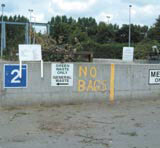Clean slate
Adding to or amending sign systems rarely improves them – it just adds to the confusion. Pamela Buxton discovers it’s best to create a system with longevity in the first place

A familiar problem is signs that carry branding. ‘Signs are for information, not branding opportunities. That’s one of the first things we tell clients,’ says Cartlidge.
‘People get confused with what’s branding and what’s information,’ adds Sam Gullam of Lacock Gullam, citing signs with the ‘Pool of London’ endorsement.
Alison Dixon, senior wayfinding designer at the Information Design Unit, says it’s best to keep everything as generic as possible – in a fast-changing hospital environment, for example, she suggests generic zone labelling such as red, green or blue rather than specific names. Likewise, in its current work advising the Natural History Museum on new signage, the group is suggesting sorting out the permanent from the semi-permanent information and keeping the latter flexible. ‹
Inappropriate physical specification is another common problem. Sign manufacturer Wood and Wood’s consultancy arm Wood and Wood Design is currently working on signs for Dublin Docklands Development Authority at Grand Canal Dock to replace a previous system that is barely a couple of years old. The printed surfaces had proved insufficiently robust for the tough area, and the stainless steel used was eroding because it was not the marine-grade specification necessary for the waterside location. The group’s solution combined the appropriate grade of stainless steel with resilient vitreous enamel for a ‘vandal-resistant’ result. Wood and Wood prides itself on its stringent testing – when manufacturing new city centre signage for Liverpool, the group built a prototype and invited a team of burly welders to do their best to wreck it in a bid to simulate the rough treatment that had beset the previous signs. The welders failed.
Good management helps, adds Gullam. ‘We encourage as good a quality system as they can afford but with a maintenance regime for information and the physical.’ While the trend is to have better capital investment in the system, getting proper investment maintenance over the next 20 years is much harder.
Ultimately, the key to longevity is the right system in the first place, as Transport for London has shown. HLS’s signs for London Underground, now 20 years old, are still performing well, helped by a seven-strong permanent planning team that ensures that the existing system of vitreous enamel signs is taken care of and adapted appropriately to take into account changes in the network. The King’s Cross Channel Tunnel Rail Link interchange, for example, will have a knock-on effect of at least 200 new route maps throughout the Tube system.
It’s a success story that any client contemplating new signs will do well to emulate. Or else they may too find themselves starting again rather sooner than they hoped.
-
Post a comment




